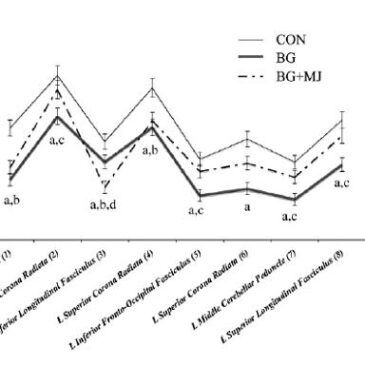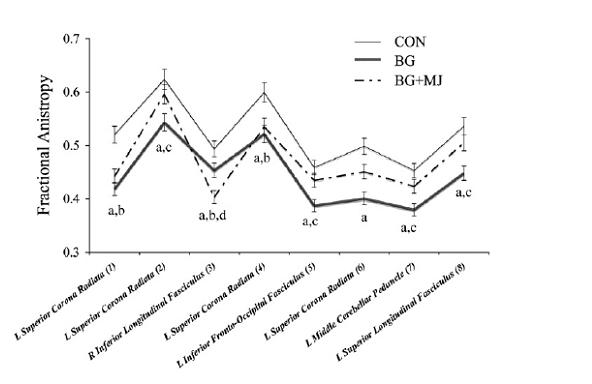Studies link abnormalities in the white matter of the brain among alcohol-dependent adults with impairment of executive functioning, working memory, and attention (Chanraud et al., 2007; Pfefferbaum et al., 2000). However, few studies have investigated white matter abnormalities in sub-clinical alcohol users, particularly adolescents. The effect of binge drinking, which is common among adolescents, coupled with marijuana use also has been largely ignored. This week’s STASH reviews an imaging study by Jacobus et al., which examined white matter abnormalities in adolescents with histories of sub-clinical binge drinking and binge drinking + marijuana use (Jacobus et al., 2009).
Methods
- Forty-two youths aged 16-19 years recruited from high schools and colleges were classified as controls (n=14), binge drinkers (n=14) or binge drinkers + marijuana users (n=14) using the Customary Drinking & Drug Use Record.
-
- Researchers classified participants as binge drinkers if they reported at least 1 episode of at least 4 drinks for females and at least 5 drinks for males.
- Researchers classified participants as binge drinkers + marijuana users if they met the criteria for binge drinkers and reported 180-1800 episodes of lifetime marijuana use.
- Using demographic variables, the study groups were well-matched, although binge drinkers + marijuana users had significantly more occasions of drinking than binge drinkers alone (p<0.05).
- Researchers performed diffusion tensor imaging (DTI) scans on study participants to assess the integrity of their white matter fiber clusters as measured by fractional anisotropy (FA) and mean diffusivity (MD).
- Lower FA values and higher MD values correlate positively with the abnormality of white matter structure.
Results
- Binge drinkers and binge drinkers + marijuana users had significantly lower FAs than controls.
-
- Binge drinkers had significantly lower FAs than controls in all 8 fiber clusters under investigation (ps<0.016).
- Binge drinkers + marijuana users had significantly lower FAs than controls in 3 of 8 clusters (ps<0.01).
- Binge drinkers had significantly lower FAs than binge drinkers + marijuana users in 4 of 8 examined clusters (ps 0.014 to 0.043).
- There were no significant differences in MD between the study groups.
Figure. Between-group FA differences (from Jacobus et al.). Click image to enlarge.
CON = Control BG = Binge drinking BG+MJ = Binge drinking + marijuana use
a = CON>BG; b = CON>BG+MJ; c = BG<BG+MJ; d = BG>BG+MJ, all p<0.05
Limitations
- Drug use history relies on self-reported data.
- Small samples, which can lead to selection bias.
- The study was not longitudinal in nature so causal relationships between drug and alcohol use and white matter abnormalities cannot be determined.
- Researchers did not investigate effect of heavy marijuana use without binge drinking on white matter fiber bundles. It is possible that binge drinking + marijuana use is protective while either alone is more damaging.
Conclusion
The results indicate that binge drinking and binge drinking + marijuana are associated with white matter damage in adolescents. From this result, the study authors conclude that marijuana use might have a protective effect against the damage caused by binge drinking. Additional research that addresses the limitations of this study is needed to fully elucidate the relationship between binge drinking, marijuana use, and white matter abnormalities and to examine the potential effects of this damage on the cognitive functioning of adolescents. Research about the broader impacts of white matter damage on adolescent health and development, such as the potential effects of white matter damage on behavior, is needed.
— Erica Marshall
What do you think? Please use the comment link below to provide feedback on this article?
References
Chanraud, S., Martelli, C., Delain, F., Kostogianni, N., Douaud, G., Aubin, H. J., et al. (2007). Brain morphometry and cognitive performance in detoxified alcohol-dependents with preserved psychosocial functioning. Neuropsychopharmacology, 32(2), 429-438.
Jacobus, J., McQueeny, T., Bava, S., Schweinsburg, B. C., Frank, L. R., Yang, T. T., et al. (2009). White matter integrity in adolescents with histories of marijuana use and binge drinking. Neurotoxicology Teratology, 31(6), 349-355.
Pfefferbaum, A., Sullivan, E. V., Hedehus, M., Adalsteinsson, E., Lim, K. O., & Moseley, M. (2000). In vivo detection and functional correlates of white matter microstructural disruption in chronic alcoholism. Alcoholism, Clinical and Experimental Research, 24(8), 1214-1221.






Mike Dennis November 11, 2009
I’m not totally clear as to the purpose of this study. Would you use this study or a larger study to encourage people to smoke marijuana to protect themselves from the potential effects of their alcohol use? This seems to me to be a study to show marijuana is not as harmful as some would suggest.